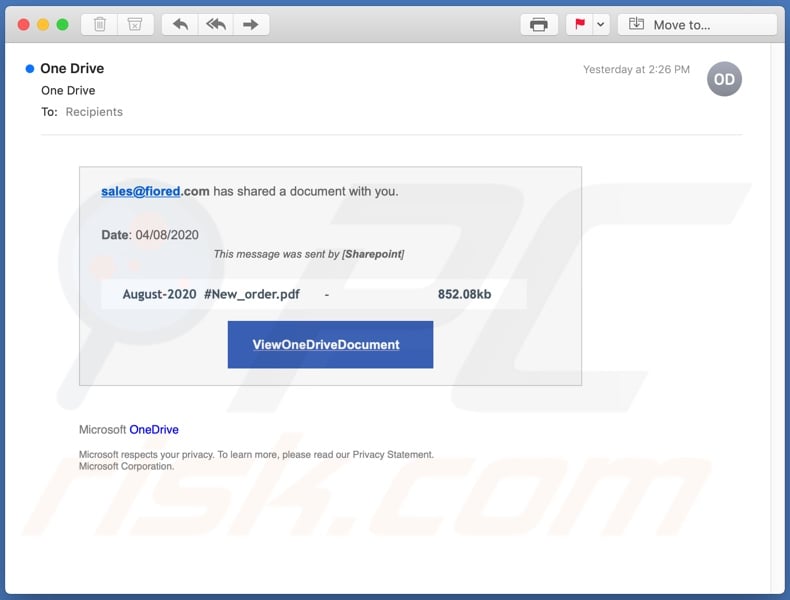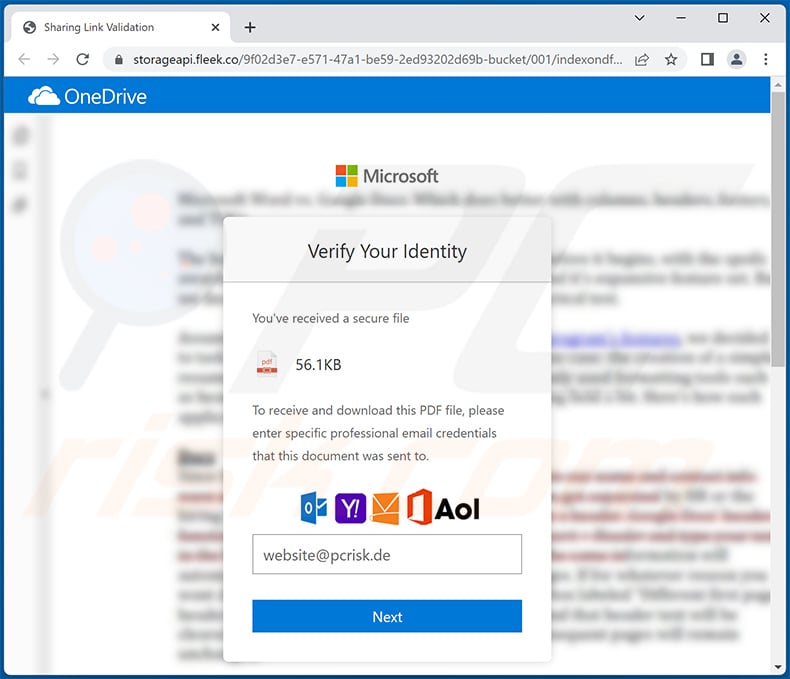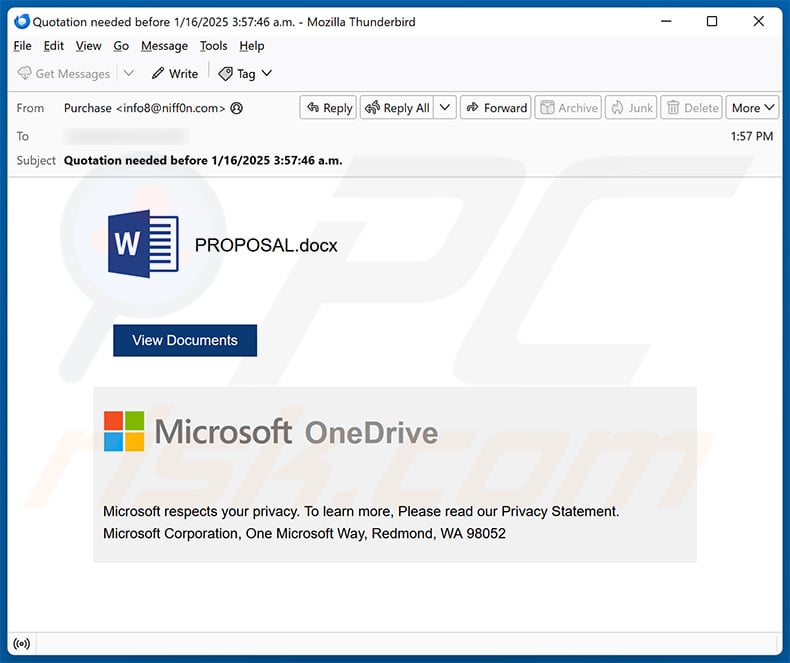Get free scan and check if your device is infected.
Remove it nowTo use full-featured product, you have to purchase a license for Combo Cleaner. Seven days free trial available. Combo Cleaner is owned and operated by RCS LT, the parent company of PCRisk.com.
What kind of scam is "OneDrive" scam?
"OneDrive Email Scam" refers to a spam campaign used to steal email account credentials (passwords) via Google Forms, a survey administration platform. The term "spam campaign" defines a large-scale operation, during which thousands of deceptive emails are sent.
The messages sent during this spam campaign claim a file has been shared with the recipients, however, when they try to access the file, they are asked to provide their email account credentials.

"OneDrive" scam in detail
The scam emails with the subject/title "One Drive" state that "sales@fiored" has shared a file with the recipients. The messages also contain the date, the document was supposedly shared. The file is allegedly named "August-2020 #New_order.pdf" (this might vary).
When users click the "ViewOneDriveDocument" button, they are redirected to a Google Forms page, which claims that they must sign in with their email account to review the document. The page contains two fields into which the email address and password must be provided.
These "One Drive" emails are fake and no file has been sent to the recipients. The web page through which users are to access the document is not a genuine sign-in/verification page. Furthermore, the page even states to "never submit passwords through Google Forms".
Scammers/Cyber criminals are particularly interested in email accounts, as they are typically connected with various other accounts. Therefore, through a stolen email, all of the associated accounts can be hijacked.
Through communication accounts (e.g. emails, social networking, social media, messengers, etc.) criminals can ask contacts for loans and/or proliferate malware (by sharing infectious files) under the guise of the genuine owner.
Stolen accounts that directly deal with or store financial information (e.g. banking account and credit card details) can be misused to make fraudulent transactions and online purchases. To summarize, trusting the "OneDrive" scam emails can lead to financial loss, serious privacy issues and even identity theft.
If attempts to log-in through the fake page have already been made, you are strongly advised to immediately change the log-in credentials of the endangered email account. It is also recommended to change the credentials of all associated accounts.
If there are further concerns, the official support of all potentially affected accounts should be contacted to resolve them.
| Name | OneDrive Email Scam |
| Threat Type | Phishing, Scam, Social Engineering, Fraud. |
| Fake Claim | Emails claim recipients have been sent a file and they must provide their account credentials to view it. |
| Symptoms | Unauthorized online purchases, changed online account passwords, identity theft, illegal access of the computer. |
| Distribution methods | Deceptive emails, rogue online pop-up ads, search engine poisoning techniques, misspelled domains. |
| Damage | Loss of sensitive private information, monetary loss, identity theft. |
| Malware Removal (Windows) |
To eliminate possible malware infections, scan your computer with legitimate antivirus software. Our security researchers recommend using Combo Cleaner. Download Combo CleanerTo use full-featured product, you have to purchase a license for Combo Cleaner. 7 days free trial available. Combo Cleaner is owned and operated by RCS LT, the parent company of PCRisk.com. |
Similar scams in general
"Important: You have 19 Pending incoming email(s)", "Dropbox Email Scam" and "Transaction received into blockchain wallet" are some examples of other similar phishing spam campaigns.
Scam emails are usually disguised as "official", "urgent", "priority" and similar, however, phishing is not the only use of spam campaigns - they are also used for other scams and malware proliferation.
Regardless of what these messages claim, request or demand, the purpose is identical: to generate revenue for the scammers/cyber criminals behind them.
How do spam campaigns infect computers?
Systems are infected via dangerous files distributed through spam campaigns. These files are attached to the emails and/or linked inside them (i.e. the messages contain download links).
Malicious files can be in various formats, such as archives (RAR, ZIP, etc.), executables (.exe, .run, etc.), Microsoft Office and PDF documents, and JavaScript. When they are executed, run or otherwise opened, the infection chain (i.e. download/installation of malware) is initiated.
For example, Microsoft Office documents infect systems by executing malicious macro commands. In Microsoft Office versions released before 2010, the infection process is initiated when a dangerous document is opened.
Later versions have "Protected View" mode, which prevents macros from being executed automatically: users are asked to enable them (i.e. to enable editing/content). Therefore, infection can only be triggered if macro commands are enabled manually.
How to avoid installation of malware
Suspect and/or irrelevant emails must not be opened, especially those with any attachments or links found in them, as this can result in a malware infection. You are advised to use Microsoft Office versions released after 2010.
As well as spam campaigns, malicious programs are also proliferated through untrusted download sources (e.g. unofficial and free file-hosting websites, Peer-to-Peer sharing networks and other third party downloaders), illegal activation ("cracking") tools and bogus updaters.
Therefore, use official/verified download channels, and activate and update programs with tools/functions provided by genuine developers. To protect device and user safety, it is paramount to have a reputable anti-virus/anti-spyware suite installed and kept up to date.
This software must be used to run regular system scans and to remove detected threats/issues. If you have already opened malicious attachments, we recommend running a scan with Combo Cleaner Antivirus for Windows to automatically eliminate infiltrated malware.
Text presented in the "OneDrive" scam email message:
Subject: One Drive
sales@fiored.com has shared a document with you.
Date: 04/08/2020
This message was sent by [Sharepoint]
August-2020 #New_order.pdf -
852.08kb
ViewOneDriveDocument
Microsoft OneDrive
Microsoft respects your privacy. To learn more, please read our Privacy Statement.
Microsoft Corporation.
Screenshot of the fake sign-in/verification page, designed to gather entered email account credentials:

Other examples of OneDrive-themed spam emails promoting various phishing sites:
Sample 1:

Text presented within:
Subject: A transfer sent to you is about to expire
OneDrive
Files sent to
********
2 items, 4.1 KB in total ・ Will be deleted on Feb16 , 2022
Thanks for using WeTransfer. We'll email you a confirmation as soon as your files have been downloaded.Download Document
2 items
Art work.pdf
3.2 KB
PO.pdf
2.9 KB
Recipients ********Message
Hello
Updated artworks and PO for the New Order have been sent to you by we transfer . Please can you download using this link. Can you deliver this order as ASAP as we wnat to make 30% deposit on 21th Feb 2022
Thanks
JennyTo make sure our emails arrive, please add noreply@wetransfer.com to your contacts.
Please do not reply to this email. We are unable to respond to inquiries sent to this address. For immediate answers to your questions, visit our Help Center by clicking "Help".
Inc. © 2022 WeTransfer
Screenshot of the promoted phishing site:

Sample 2:

Text presented within:
Subject: File " ******** /Overdue Invoices MAY 2022.pdf" has been shared with you 13.6.2022 9:26:01
OneDrive
********You have a new document on OneDrive.
Payment Statement.pdf
View on OneDriveFree online storage for your files. Check it out .
Microsoft respects your privacy. For more information, read our Privacy Statement.
Microsoft Corporation, One Microsoft Way, Redmond, WA, 98052
Screenshot of the promoted phishing site:

Sample 3:

Text presented within:
Subject: - received a share document via Onedrive
OneDrive
View payment receipt
A new contract documents has been shared with you on OneDrive Storage.
Message: Please review contract documents for your signing and approval.
View DocumentUnsubscribe From This List | Manage Email Preferences
Screenshot of the promoted phishing site:

Sample 4:

Text presented within:
Subject: - sent a file
Hi -,
You have received a document via OneDrive, find details below:
Total files size (3.49 MB)
*File name: XeroScan_SOA_0902237.xlx
VIEW FILE ONLINE/DOWNLOAD
Thank you,
OneDrive Services.
All Rights Reserved (2023).
Sample 5:

Text presented within:
Subject: FW: Contract Documents - -
Dear Supplier,
Please refer to the document I’ve shared with you via one drive
We have just issued a new contact supply to your company .Review And Download Our Contract Documents:
Review DocumentCan you also meet up with an order to make supply to our buyer in Canada.
Waiting to read from you soon.
Kind regards
James B
Purchasing Manager
Commerce specialist of Int'l
Commerce dept
DLTel+1 (929) 322-373188
84 Wmple Street, Miami
Tel+1 (929) 322-331898
Fax+1 (929) 322-331880
Sample 6:

Text presented within:
Subject: You recieved a file via Onedrive
OneDrive
Hi ********
Due invoices has been shared with you on ******** One-Drive portal.
Kindly review invoices on the link below for your approval.
File Size : 300kb | Expires in 7daysView Invoice
Session ID : 29434 | ********
Kind Regards,
Fisioline Account Portal
Sample 7:

Text presented within:
Subject: Quotation needed before 1/16/2025 3:57:46 a.m.
PROPOSAL.docx
View Documents
Microsoft OneDrive
Microsoft respects your privacy. To learn more, Please read our Privacy Statement.
Microsoft Corporation, One Microsoft Way, Redmond, WA 98052
Instant automatic malware removal:
Manual threat removal might be a lengthy and complicated process that requires advanced IT skills. Combo Cleaner is a professional automatic malware removal tool that is recommended to get rid of malware. Download it by clicking the button below:
DOWNLOAD Combo CleanerBy downloading any software listed on this website you agree to our Privacy Policy and Terms of Use. To use full-featured product, you have to purchase a license for Combo Cleaner. 7 days free trial available. Combo Cleaner is owned and operated by RCS LT, the parent company of PCRisk.com.
Quick menu:
- What is OneDrive spam?
- Types of malicious emails.
- How to spot a malicious email?
- What to do if you fell for an email scam?
Types of malicious emails:
![]() Phishing Emails
Phishing Emails
Most commonly, cybercriminals use deceptive emails to trick Internet users into giving away their sensitive private information, for example, login information for various online services, email accounts, or online banking information.
Such attacks are called phishing. In a phishing attack, cybercriminals usually send an email message with some popular service logo (for example, Microsoft, DHL, Amazon, Netflix), create urgency (wrong shipping address, expired password, etc.), and place a link which they hope their potential victims will click on.
After clicking the link presented in such email message, victims are redirected to a fake website that looks identical or extremely similar to the original one. Victims are then asked to enter their password, credit card details, or some other information that gets stolen by cybercriminals.
![]() Emails with Malicious Attachments
Emails with Malicious Attachments
Another popular attack vector is email spam with malicious attachments that infect users' computers with malware. Malicious attachments usually carry trojans that are capable of stealing passwords, banking information, and other sensitive information.
In such attacks, cybercriminals' main goal is to trick their potential victims into opening an infected email attachment. To achieve this goal, email messages usually talk about recently received invoices, faxes, or voice messages.
If a potential victim falls for the lure and opens the attachment, their computers get infected, and cybercriminals can collect a lot of sensitive information.
While it's a more complicated method to steal personal information (spam filters and antivirus programs usually detect such attempts), if successful, cybercriminals can get a much wider array of data and can collect information for a long period of time.
![]() Sextortion Emails
Sextortion Emails
This is a type of phishing. In this case, users receive an email claiming that a cybercriminal could access the webcam of the potential victim and has a video recording of one's masturbation.
To get rid of the video, victims are asked to pay a ransom (usually using Bitcoin or another cryptocurrency). Nevertheless, all of these claims are false - users who receive such emails should ignore and delete them.
How to spot a malicious email?
While cyber criminals try to make their lure emails look trustworthy, here are some things that you should look for when trying to spot a phishing email:
- Check the sender's ("from") email address: Hover your mouse over the "from" address and check if it's legitimate. For example, if you received an email from Microsoft, be sure to check if the email address is @microsoft.com and not something suspicious like @m1crosoft.com, @microsfot.com, @account-security-noreply.com, etc.
- Check for generic greetings: If the greeting in the email is "Dear user", "Dear @youremail.com", "Dear valued customer", this should raise suspiciousness. Most commonly, companies call you by your name. Lack of this information could signal a phishing attempt.
- Check the links in the email: Hover your mouse over the link presented in the email, if the link that appears seems suspicious, don't click it. For example, if you received an email from Microsoft and the link in the email shows that it will go to firebasestorage.googleapis.com/v0... you shouldn't trust it. It's best not to click any links in the emails but to visit the company website that sent you the email in the first place.
- Don't blindly trust email attachments: Most commonly, legitimate companies will ask you to log in to their website and to view any documents there; if you received an email with an attachment, it's a good idea to scan it with an antivirus application. Infected email attachments are a common attack vector used by cybercriminals.
To minimise the risk of opening phishing and malicious emails we recommend using Combo Cleaner Antivirus for Windows.
Example of a spam email:

What to do if you fell for an email scam?
- If you clicked on a link in a phishing email and entered your password - be sure to change your password as soon as possible. Usually, cybercriminals collect stolen credentials and then sell them to other groups that use them for malicious purposes. If you change your password in a timely manner, there's a chance that criminals won't have enough time to do any damage.
- If you entered your credit card information - contact your bank as soon as possible and explain the situation. There's a good chance that you will need to cancel your compromised credit card and get a new one.
- If you see any signs of identity theft - you should immediately contact the Federal Trade Commission. This institution will collect information about your situation and create a personal recovery plan.
- If you opened a malicious attachment - your computer is probably infected, you should scan it with a reputable antivirus application. For this purpose, we recommend using Combo Cleaner Antivirus for Windows.
- Help other Internet users - report phishing emails to Anti-Phishing Working Group, FBI’s Internet Crime Complaint Center, National Fraud Information Center and U.S. Department of Justice.
Frequently Asked Questions (FAQ)
Why did I receive this email?
Typically, scammers send the same email letter to all addresses in their database. They obtain addresses after data breaches and in similar ways.
I have provided my personal information when tricked by this email, what should I do?
If you have provided your password, change all your passwords as soon as possible (especially if any other accounts use the same password).
I have downloaded and opened a file attached to an email used to distribute malware, is my computer infected?
It depends on the file. If you opened a malicious executable, your computer is probably already infected. In other cases, it is not enough to open malicious files (e.g. archive files like ZIP, RAR, MS Office documents) to infect computers.
I have read the email but didn't open a malicious attachment, is my computer infected?
Clicking links and opening attachments causes computer infections. Opening emails does not cause any damage.
Will Combo Cleaner remove malware infections that were present in email attachment?
Yes, Combo Cleaner can detect and remove almost all known malware. High-end malware usually hides deep in the operating system (it is not enough to run a quick system scan to detect it). For this reason, running a full system scan is a must.
Share:

Tomas Meskauskas
Expert security researcher, professional malware analyst
I am passionate about computer security and technology. I have an experience of over 10 years working in various companies related to computer technical issue solving and Internet security. I have been working as an author and editor for pcrisk.com since 2010. Follow me on Twitter and LinkedIn to stay informed about the latest online security threats.
PCrisk security portal is brought by a company RCS LT.
Joined forces of security researchers help educate computer users about the latest online security threats. More information about the company RCS LT.
Our malware removal guides are free. However, if you want to support us you can send us a donation.
DonatePCrisk security portal is brought by a company RCS LT.
Joined forces of security researchers help educate computer users about the latest online security threats. More information about the company RCS LT.
Our malware removal guides are free. However, if you want to support us you can send us a donation.
Donate
▼ Show Discussion